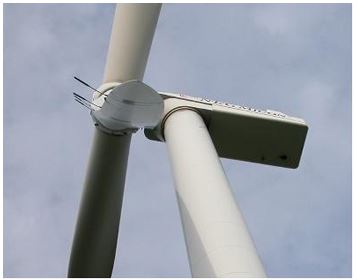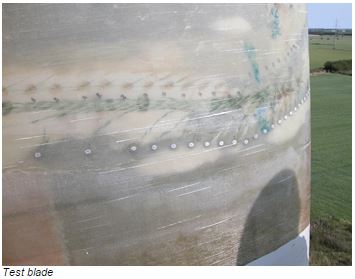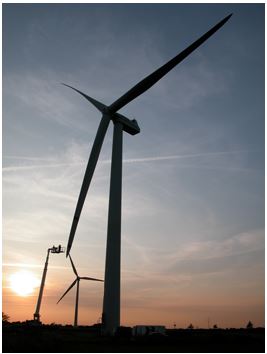Risø DTU has just concluded a large full-scale experiment on a wind turbine at Tjæreborg Enge near Esbjerg on the west coast of Jutland. It is the first time that anybody has carried out detailed measurements of the load distribution on a 40-metre-long blade under natural wind conditions, thereby providing a very accurate picture of the wind flow over the wind turbine blade surface.
The National Laboratory for Sustainable Energy, Risø DTU has been able to initiate the measurements and pool the resources of the four largest companies in the Danish wind power industry behind the DAN-AERO MW experiment. The experiment is a natural follow-on to the long-standing collaboration between the research community and industry which has secured a leading position for Denmark within wind power.
The project was spearheaded by Helge Aagaard Madsen, Research Specialist, and Christian Bak, Senior Scientist with Risø DTU’s Wind Energy Division, but would not have been possible without the four other partners, Vestas, Siemens, LM Glasfiber and DONG. The four partners have all made considerable contributions in the form of both financial resources and their extensive know-how.
The blade was built by LM Glasfiber and features 350 measuring points in the form of pressure sensors, microphones etc., all connected to a measuring laboratory at the root of the blade. Det Norske Veritas reviewed the safety calculations for the blade which, with all the equipment, was somewhat heavier than a normal blade, and found that the wind turbine should be allowed to operate at maximum wind speeds of 15 metres per second. And as the measuring points would tolerate absolutely no moisture, the experiment had to take place under perfectly dry weather conditions.

Outside the measuring periods, the measuring points were covered with tape, of which huge quantities were used during the project. A total of twelve measuring periods were successfully fitted in between the end of June and the middle of September, resulting in a vast volume of data. With a view to processing these data, the consortium is currently applying for funding from the Danish Energy Agency under the Energy Technology Development and Demonstration Program (EUDP).
Detailed measurements
So far, very few experiments of this type aimed at measuring blade surface pressure have been conducted, and those which have taken place have primarily been in the USA and the Netherlands. However, in the past such measurements have been carried out on small-scale research wind turbines, and many of them under so-called controlled wind conditions in wind tunnels.
“Our measurements are by far the most comprehensive to date, and because they were conducted out in the open and on an industrial full-scale wind turbine, they take account of the impact of turbulence and blade rotation as well as elasticity. There is no doubt that they will be valuable for international wind energy research as a whole,” says Helge Aagaard Madsen. “Moreover, we have - so to speak - been listening to the air flow across the blade using 60 microphones and recording 50,000 measurements a second, thereby obtaining an extremely detailed picture of how the wind is translated into load on the blades, i.e. looking at what lies at the very heart of utilising wind power.”
Very importantly, the experiment aims to provide a basis for designing the optimum blade profile, striking the right balance between design robustness and sensitivity and ensuring that as much energy can be generated as possible and in as reliable a manner as possible.
One thing getting in the way of wind turbine blades is insects in the air. They stick to the blades, and should ideally be wiped off at regular intervals. You can spend a lot of time wiping insects off a glider’s wings, but not off a wind turbine blade 60 metres above ground.

Wind tunnel and analysis to follow
In November, more measurements will be carried out on copies of certain sections of the blade in LM Glasfiber’s wind tunnel in Lunderskov. This will allow the scientists to establish the difference between the properties of a blade profile on a full-scale wind turbine in the open air, and the properties of a similar profile under controlled wind conditions in a wind tunnel. This has been the main purpose of the project, and in future it will provide a more reliable basis for designing new airfoils and blades and ultimately the entire wind turbine.
The project will be concluded at the end of 2009, but hopefully a new project will start up in the new year.
“It is crucial that we find the funding needed to analyse all our data. Only then will all the unique measurements have any value,” says Christian Bak.
Several experiments rolled into one
Furthermore, the unique experiment is also in a class of its own because several measurements were made as part of the same experiment.
As part of an ERP2007-II project, DELTA Akustik carried out noise measurements near the wind turbine, standing on the ground holding microphones to measure the blade noise.
A laser-based wind scanner developed by Risø DTU was tested as part of the UPWIND EU project. The scanner makes it possible to carry out three-dimensional measurements of wind speeds, wind direction and turbulence around a wind turbine. On this occasion, the concept of sending a laser beam from the wind turbine and up against the wind underwent further testing.
Finally, as part of the TOPFARM EU project, another laser was used to measure the velocity distribution in the wake of the rotor. The data gathered are important because many wind turbines are erected as part of wind farms. Many wind turbines thus stand behind other wind turbines and are consequently exposed to the irregular wind patterns created by the wind turbine in front.
Together with the DAN-AERO MW experiment, these three experiments provide a complete picture of the conditions under which modern giant wind turbines operate. The ensuing analysis of these measurements will therefore create a new basis for designing large-scale modern MW wind turbines.

In addition to Risø DTU, members of the consortium behind the DAN-AERO MW experiment in Tjæreborg are Vestas, Siemens, LM and DONG Energy which have invested approx. DKK 5 million in the project. Funding has also been granted by the Danish Energy Research Programme EFP-2007.
Head of project: Research Specialist Helge Aagaard Madsen, Risø DTU, tel. +45 4677 5047
Senior Scientist Christian Bak, Risø DTU, tel. +45 4677 5091